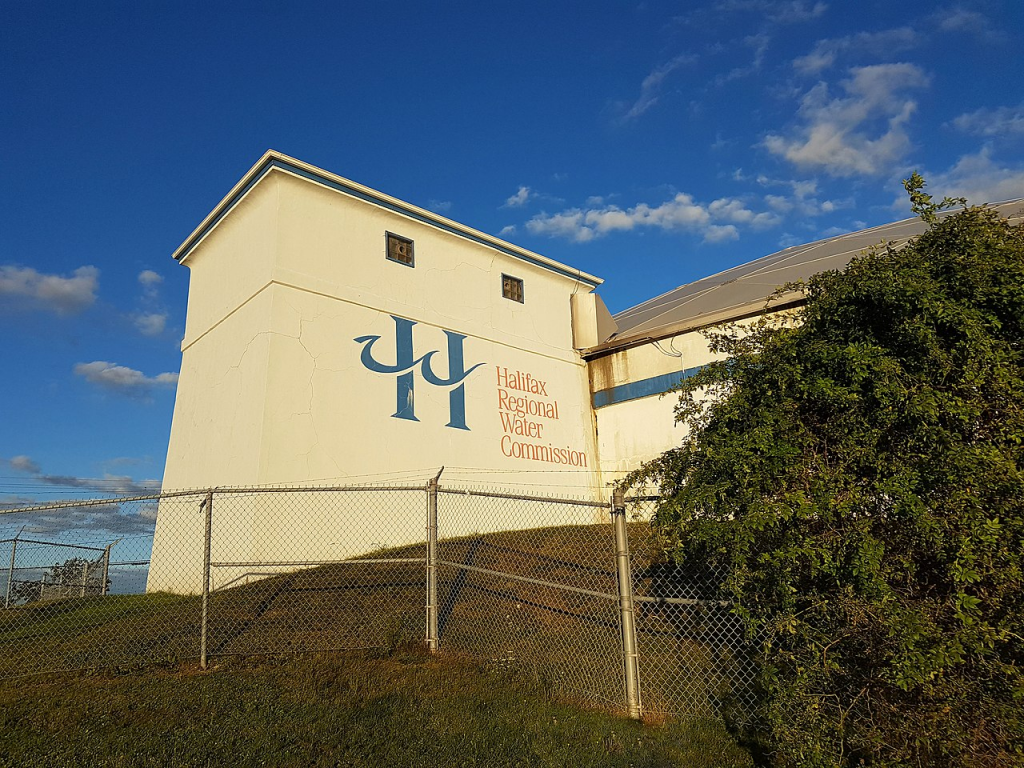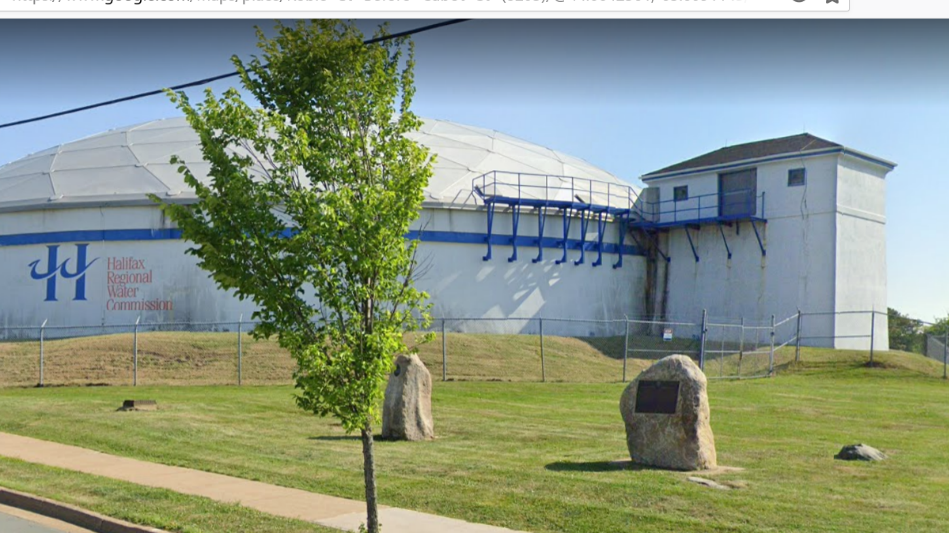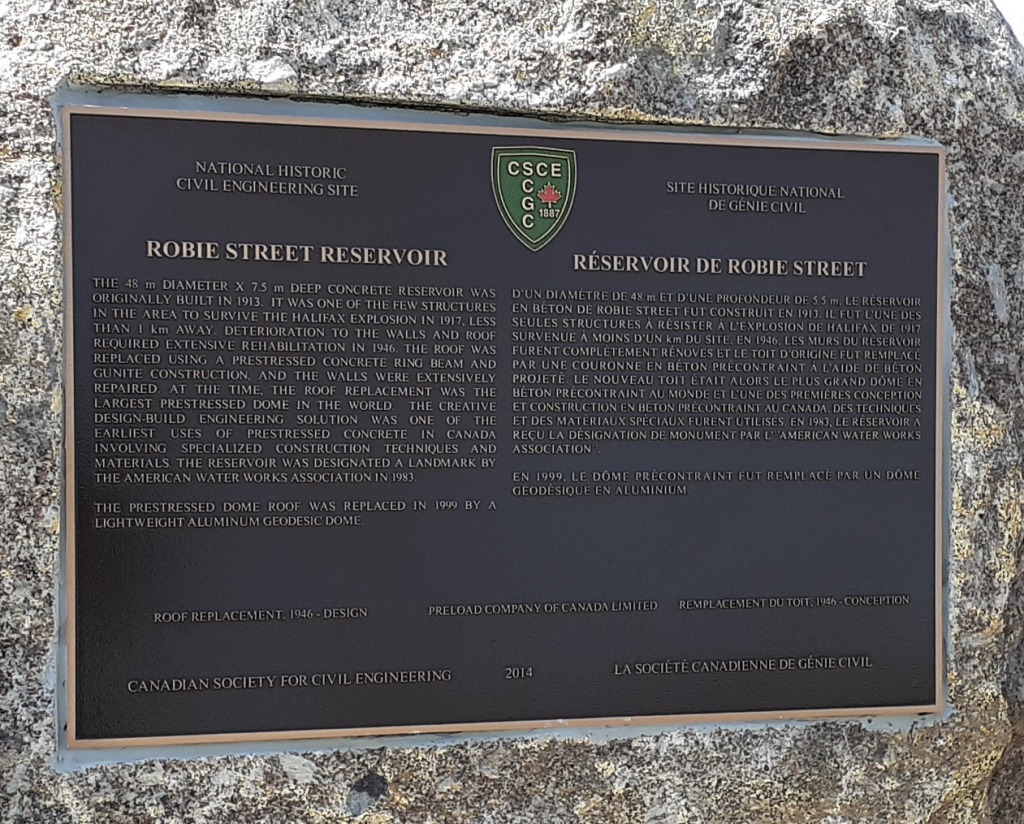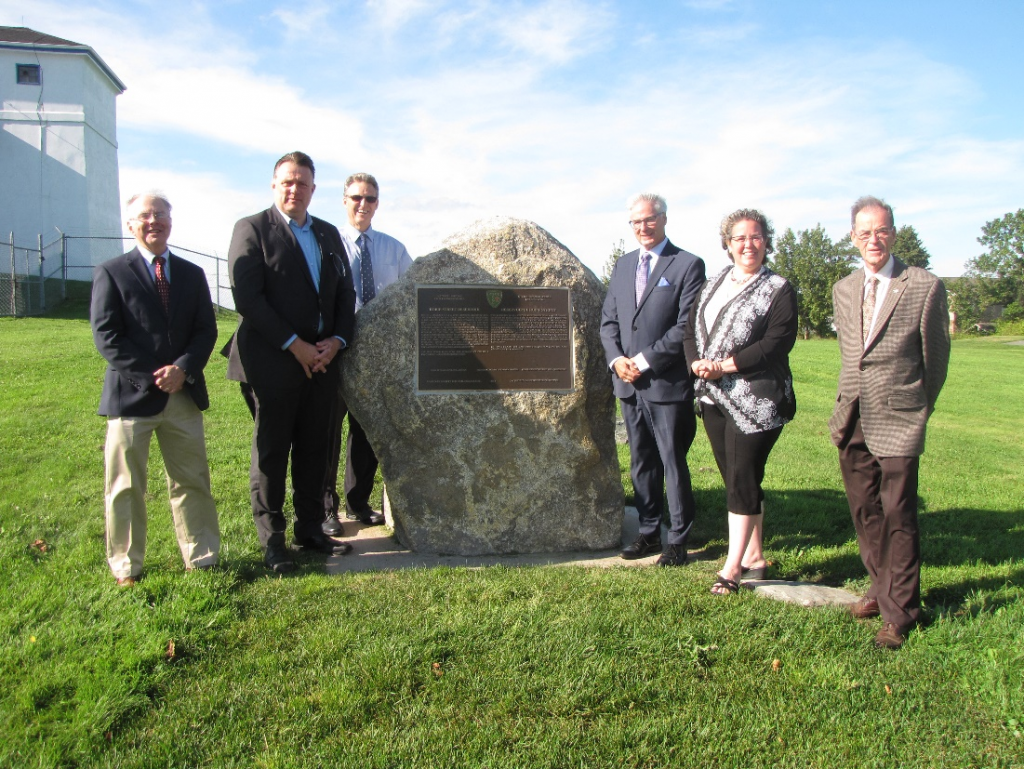
Site Location: Lat.: 44° – 39’ – 51” N.; Long.: 63° – 36’ – 33” W. (GPS: 44.6642361, -63.6091145). Travelling south on NS-102 S in Halifax, continue straight for 1.8 km on Bayers Road to Windsor Street where Bayers Road becomes Young Street. Continue 0.55 km on Young Street, turn left (northwest) on Robie Street, and proceed 0.45 km to find the reservoir on the left (west).
Plaque Location: The plaque is mounted on the face of a large boulder just north of the reservoir.


Description: The Robie Street High Service Reservoir, constructed originally in 1913, has an inner diameter of 29 m (160 ft.), a height of 7.6 m (25 ft.) and a capacity of 14.2 million litres (3.1 million gal.). The heavily reinforced walls taper from 450 mm (18 in.) at the top to 900 mm (3 ft.) at the base. The original roof was a 100 mm (4 in.) concrete slab supported on beams and 53 interior columns.
By 1946, the roof and walls were badly deteriorated. The walls were repaired, sometimes replacing the entire wall thickness, using gunite. In accordance with a design by the Preload Company of Canada Ltd., a 75 mm (3 in.) gunite dome was placed on roof formwork, in a five-day round-the-clock operation, anchored by a new ring beam cast at the top of the wall. The ring beam was then prestressed by 350 turns of a continuous strand placed in five layers, with a layer of shotcrete between each layer. The new roof had a mass of 500 tonnes (550 tons) and the new ring beam contained 72 km (42 mi.) of prestressing strand.
The 1946 roof was replaced in 1999 by the current geodesic dome aluminium roof. This intricate procedure involved controlled blasting to remove the concrete dome in conjunction with the release of the post-tensioning in the concrete ring beam.



Historic Significance: The Robie Street Reservoir has been an essential component of the Halifax water supply system for over a century. It was one of the few structures in the area to survive the 1917 Halifax explosion, less than 1 km away.
The 1946 replacement roof was the largest prestressed dome in the world. It was structurally efficient, requiring less than half the quantity of concrete and reinforcing steel as the original reinforced concrete roof. The creative design-build engineering solution was one of the earliest uses of prestressed concrete in Canada involving specialized construction techniques and materials.
The 1999 project is believed to be the largest dome replacement in Canada.

Plaque Wording: National Historic Civil Engineering Site. CSCE. ROBIE STREET RESERVOIR. The 48 m diameter x 7.5 m deep concrete reservoir was originally build in 1913. It was one of the few structures in the area to survive the Halifax Explosion in 1917, less than 1 km away. Deterioration to the walls and roof required extensive rehabilitation in 1946. The roof was replaced using a prestressed concrete ring beam and gunite construction, and the walls were extensively repaired. At the time, the roof replacement was the largest prestressed dome in the world. The creative design-build engineering solution was one of the earliest uses of prestressed concrete in Canada involving specialized construction techniques and materials. The reservoir was designated a landmark by the American Water Works Association in 1983. The prestressed dome roof was replaced in 1999 by a lightweight aluminum geodesic dome. Roof replacement, 1946 - Design Preload Company of Canada Limited. Canadian Society for Civil Engineering. 2014.
SCGC. Site Historique National de Génie Civil. RÉSERVOIR DE ROBIE STREET. D’un diamétre de 48 m et d’une profondeur de 5.5 m, le réservoir en béton de Robie Street fut construit en 1913. Il fut l’une des seules structures à résister à l’explosion de Halifax de 1917 survenue à moins d’un km du site. En 1946, les murs du réservoir furent complètement rénovés et le toit d’origin fut remplacé par un couronne en béton précontraint à l’aide de béton projeté. Le nouveau toit était alors le plus grand dôme en béton précontraint au monde et l’une des premières conception et construction en béton précontraint au Canada. Des techniques et des matériaux spéciaux furent utilisés. En 1983, le réservoir a reçu la désignation de monument par l’ “American Water Works Association”. En 1999, le dôme précontraint fut remplacé par un dôme géodésique en aluminium. Preload Company of Canada Limited Remplacement du toit, 1946 – conception. 2014. La société canadienne de génie civil.
Plaque Unveiling Ceremony: The plaque was unveiled on the afternoon of May 30, 2014, at a ceremony held at the Halifax Shipyard, Irving Shipbuilding Inc. Carl Yates was the Master of Ceremonies and Peter Williams, VP Operations of Irving Shipbuilding, welcomed the guests present. After remarks by Reg Andres, CSCE President, and Cal Sexsmith, Chair of the CSCE National History Committee, the plaque was unveiled by Reg Andres and Colleen Purcell, Halifax Water. The plaque was received by Colleen Purcell.

Link to Online Documentation:
Halifaxbloggers.ca, “The Robie Street High Service Reservoir”.